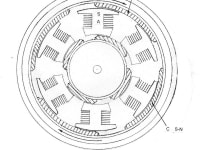This new technology has many applications, suitable for Linear electric motors, Electric Gear Box and Clutch or as an Electric Braking System. In the Electric Gear Box and Clutch, the backing plate that the energised coils are mounted onto can rotate, making it a floating clutch, while as an Electric Braking System, the backing plate that the energised coils are mounted onto, is fixed to the center axle and does not rotate. The energised coils react with the permanent magnets in the rotor to provide a means to provide high torque braking of the rotor using the forces of magnets, without the friction and heat generated by physical contact between two surfaces. There are 1.2 Billion Vehicles on the Worlds Roads with 253 Million cars and trucks on U.S. roads, each vehicle has four wheels, and trucks many more. There were aproximately 5.6 million car crashes in America last year due to brake failure. A system that turns a conventional or In Hub wheel motor into a equally effective brake, which never needs new brake linings, no hydraulics, no brake fluid to leak, no costly maintainence or repairs, no brake failure due to heavy load or high speeds, that has to be a life saver, and is cheaper to produce. How does it work ? by turning the fundermental principles of an electric motor, attraction and repulsion in reverse, so its repulsion and attraction. Let me give you an example. In the drawings A is an energised coil, B is a through magnetised permanent magnet with the North magnetic face on the inward side, C is a through magnetised permanent magnet with the South magnetic face on the inward side. As an electric motor, the sequence would be the outside magnetic pole on the energised coil would be a South magnetic pole, unlike magnetic poles attract, so B is attracted to A. C is South magnetic pole, and is repelled by A. When B lines up with A, the direction of the electric current is reversed, so now A is a North magnetic pole, and as like poles repel, B is now repelled in the direction of the arrow, while C now comes under the infuence of the next energised coil and is attracted. But as an electric brake, the sequence is the opposite, fig.1 A is a north magnetic pole, and B is now trying to repel A, C is attracted to A, but friction of the wheel on the ground, and inertia of the rotor force B to line up to A fig.2, when this occurs, A is changed to a South magnetic pole, and fig.3 B is attracted to A, but is now forced to part from A. This sequence occurs on both sides of the energised coils and on all energised coils. If used on a conventional electric motor, it occurs only on the outside of the energised coils. The braking ability and efficiency is the same torque as the electric motor.
Like this entry?
-
About the Entrant
- Name:John Ettridge
- Type of entry:individual
- Patent status:pending








